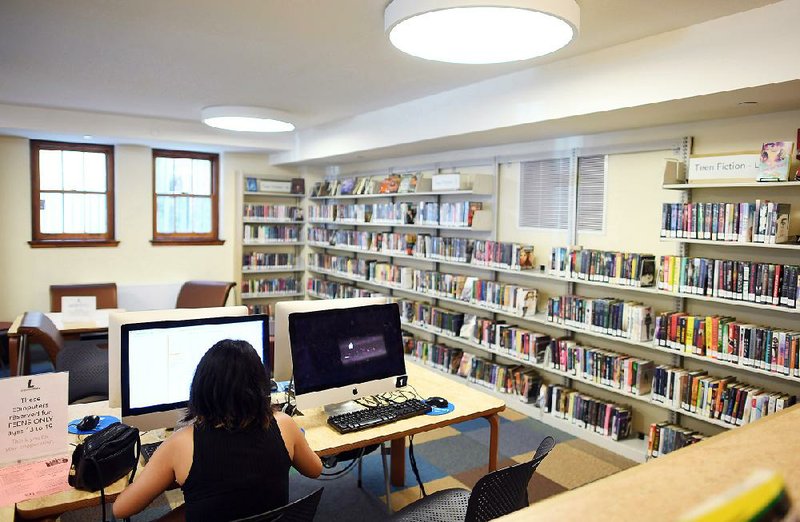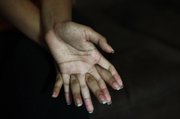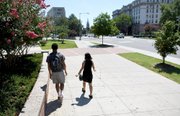The other kids are talking about their phones again, and she is trying not to listen.
She likes it here, in the big room at the library in northwest Washington, where she comes twice a week for her after-school youth program. In this space, 15-year-old DJ knows she can be honest, even when she feels different -- like she does now, as the teens sitting around her gaze at their smartphone screens and commiserate over the frustration of dying batteries.
DJ (who is identified only by her initials to protect her privacy) focuses instead on the art project in her hands, a paper model of BB-8, the spherical robot from Star Wars: Episode VII -- The Force Awakens. She picks up a pair of scissors, her dark eyes squinting behind her black-rimmed glasses, and carefully cuts along the dotted line.
"You know when your phone ..." one boy begins, and now DJ looks up.
"I don't have a phone," she says.
"Don't keep rubbing it in," Dia Bui, the program coordinator, tells the boy.
The program technically ended 15 minutes ago, at 6 p.m., but DJ isn't in a hurry to leave. She gets lonely at home, she says. Her mother often has to work late, and her brothers are often busy with their friends. So DJ usually retreats to her small bedroom, hidden behind a floor-length curtain, where she curls up on a bed strewn with clothes and piled high with stuffed animals.
"It's sad sometimes when I'm left alone with my thoughts," she says.
There is no beeping or buzzing, no message notifications to answer or apps to preoccupy her. At a time when many parents agonize over their kids' consumption of social media -- fretting over the hours spent playing games, posting Instagrams and incessantly texting -- DJ represents the flip side: teens who can't afford phones or computers and don't have reliable Wi-Fi at home.
They are the outliers. The Pew Research Center reports that 88 percent of all American teens ages 13 to 17 own or have access to a cellphone, and most -- 73 percent -- have smartphones. Technology that was once considered a luxury is now viewed as a necessity.
STILL OUT OF REACH
But for some low-income families like DJ's, these devices are still out of reach. Not having a phone or a computer compounds her other worries: the sense of isolation from her classmates, the struggle to keep up at school, the difficulty of finding resources that might offer academic or emotional help.
She finds other ways to occupy herself. "I started using my sketchbook more," DJ says. "But my teacher asks us to draw from references, to use the internet to look up things to draw, and I can't."
Someday she wants to go to a great college, to become a famous artist, to make a lot of money and provide for a family. But lately, she hasn't been doing her homework, because almost all of it is online, and she can't get online at home. She has been missing her childhood friends, the ones who moved away before high school started. She used to talk to them all the time over text and Snapchat before her iPhone broke.
The phone was a long-awaited Christmas present from DJ's mother, Lidia. For months, it was DJ's lifeline. Then the battery stopped charging and the screen went dark.
Lidia, a 33-year-old single mother who came to the United States from Guatemala when she was 16, works at a salon six days a week to support DJ and her two brothers. Replacing the phone wasn't an option.
"It's expensive," Lidia says, again, after DJ arrives at their ground-level apartment and curls up on the couch beside her. Lidia nudges her daughter playfully. "Even your mom can't get a new phone.
"When we were young, we didn't have those things," she continues.
"But now it's different," DJ says. "Because everybody has technology, and then you're the one person left out."
NEVER MORE PROFOUND
The effect on the few who remain technologically disconnected has never been more profound -- especially for the teens, like DJ, who are part of the most digitally defined generation in history. Almost everything they need exists in cyberspace: Hard-copy workbooks have been replaced by online libraries. Homework assignments and practice exercises are posted to school websites. Instead of meeting up in the library for study groups, students collaborate remotely through cloud applications. Test preparation, college applications, employment and internship opportunities -- all of it is online.
Families are adapting to this new reality, and the digital division between those who can and cannot afford technology is narrowing. This year, the Joan Ganz Cooney Center at Sesame Workshop released the first nationally representative survey of low-income parents focused on digital connectivity. It showed that 91 percent of families living below the poverty line have an internet connection at home.
But many of those households remain "under-connected," meaning their internet access is inconsistent at best, and often available only through a phone. This is the case in DJ's home, where other utility bills frequently take priority over Wi-Fi, and the three siblings sometimes share one smartphone to do homework. The survey also found that families headed by Hispanic immigrants, such as DJ's mother, are the least connected of all low- and moderate-income American families.
Students without home access can turn to school computer labs or public libraries, which might mean staying late after class, riding public transportation alone, waiting in line for a computer or grappling with a slow, overtaxed connection. This might not seem like such an excessive burden, except that it generally falls on the already-overwhelmed kids who are least able to bear it.
Not having a phone isn't, in itself, a terrible thing. Some families who can afford the devices prefer to keep their kids away from them. But for underpriviledged teens, not having a phone or computer is just one of a myriad of challenges they face, says Mary Brown, executive director of the D.C. Promise Neighborhood Initiative.
Her organization recently worked with Comcast to provide low-cost internet connections to impoverished families in the District of Columbia. "Having access to the internet -- it's just huge, to have that at home," she says.
For teens shut out of the social-media world their friends inhabit, the exclusion isn't trivial. When teens can't relate to what their peers are doing, they miss out on a basic cultural fluency.
SOCIAL CONSEQUENCES
Sara Kirschner, curricula and training manager for Higher Achievement, a national academic program for middle-school students, has seen the social consequences for students who don't have the same digital privileges as their peers.
"Even when their phones aren't out, kids chat about what's going on online," she says. "And the kids without technology can't even engage in the conversation."
The promise of summer is escape, a time to go away to camp or to the beach. For DJ, summer is just more time spent at home, away from her classmates, where boredom and isolation make the long days feel even longer.
But there was relief this summer through a regional youth program called Asian American Leadership, Empowerment and Development, or AALEAD, which offers support to low-income black and Hispanic children. For six weeks, DJ enjoyed time with friends, free meals and held her first paid job -- the program hired her as an intern.
During the summer session, DJ worked with several friends on a group project, a short video documentary about gentrification in D.C. The team took photos in Columbia Heights, Navy Yard and Chinatown, speaking to workers and residents, capturing ways the communities have changed. Then the girls recorded interviews with each other, talking about how those changes made them feel.
DJ says the project helped her understand why so many of her childhood friends have moved away.
One sweltering morning, the team members arrived at Martin Luther King Jr. Memorial Library, where AALEAD had reserved a row of gleaming white Apple computers for them to use to edit their footage -- but the software baffled the teens, who had never used it before.
DJ says she feels "different" because she doesn't have a phone, but the truth is she felt different even when she did have one. At her high school across town, she is among a minority of students who qualify for free or reduced-price lunch, and many of her classmates are from wealthier neighborhoods. On Instagram, she watched their lives unspool in an endless feed of picture-perfect moments, flawless selfies and luxurious vacations. The privilege DJ saw every day in class followed her home in her pocket.
"Instagram is for people with interesting lives," she says. "I didn't think my life was so interesting, to put it out there like that." She posted a selfie only once, she says, and took it down a few hours later.
SHRINKING SOCIAL CIRCLE
She found herself obsessing over how many followers she had, comparing the number with her friends' accounts. She started noticing when her friends unfollowed her, mirroring her shrinking social circle. Five months after she added the app, she deleted it.
"I was afraid people would really look at me and judge me," she says. "It made me feel bad about myself."
But she misses other apps, the ones that offered an escape. She loved the whimsical filters on Snapchat, how, with the flick of her finger, she could become a goddess with flowers in her hair.
But she never did get used to seeing herself on a screen. So when her group video project was played at a local coffee shop, as part of a celebration at the end of AALEAD's summer session, DJ was excited and proud but also a little nervous. Dozens of teens and staff members gathered to recognize the students and applaud their work. All those people watched her on video, in the interview where she talked about what life is like in her city.
When the music stopped and the film started playing, DJ quickly retreated to the second floor of the cafe, leaning against the railing as she gazed down on the crowd below. Her face stared back at her from the screen against the wall.
Off camera, an interviewer asks: Are there opportunities for youth in your community?
DJ's answer is immediate and absolute.
"No," she says. "Everything costs money."
Family on 09/14/2016



